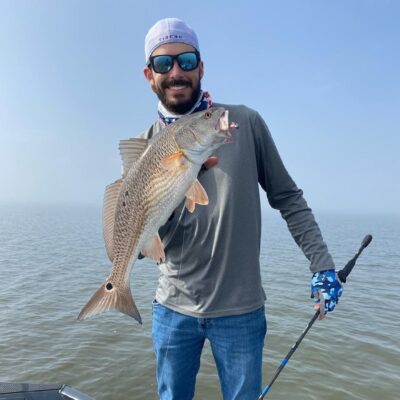LDWF to Stock Calcasieu Lake with 10,000 Redfish Fingerling
Keith Lusher 08.14.23


The heated debate over reducing redfish limits in Louisiana is still ongoing, however the Louisiana Department of Wildlife and Fisheries is going on the offensive by providing a special permit to transport and stock approximately 10,000 redfish fingerlings in the Calcasieu Lake estuary. The stocking is part of a pilot project to investigate the biological and ecological efficacy of stocking with hatchery-raised fish.
The fish are expected to be stocked during 2023 and 2024. However, the permit will expire on December 31, 2023, and will require renewal prior to any stocking activities occurring in 2024.
LDWF will assist with evaluation of the success of the project by genetic monitoring during fish releases and collecting fish samples in subsequent years for genetic testing. RFRI, a Louisiana-based non-profit, conducts marine fisheries restoration through education and public involvement. The fingerlings will be stocked by the Recreational Fisheries Research Institute (RFRI), which sought the project, along with cooperation from the Coastal Conservation Association of Louisiana.
RFRI is covering the costs of stocking and genetic analysis as part of the permit stipulations.
“We know that redfish are important to our citizens, the economy, and the ecosystem. We want to evaluate all options to recover the stock in coastal waters and this will be the first ever evaluation of redfish stocking in Louisiana,” said LDWF Secretary Rob Shadoin.
Although redfish have been stocked in other states such as Texas, the department says it wants to temper the expectations related to this effort here in Louisiana.
“With the recent stock assessment showing that our red drum population has an over 1.5 million fish deficit compared to the long term recruitment average, stocking efforts will not solve the issues facing red drum in Louisiana,” said LDWF Assistant Secretary for Fisheries Patrick Banks. “Stocking of hatchery-reared fish is rarely the solution to a fish population problem in nature, but it could serve a useful purpose in the future. We hope to determine if stocked fish are able to survive in the Calcasieu Estuary and at levels that can be tracked via genetic testing.
“Regulatory changes, such as those recently proposed by the Louisiana Wildlife and Fisheries Commission, are still necessary to recover the red drum stock from the overfished condition, but we are exploring all options,” Banks added. “This limited permit allows us to perform the necessary scientific evaluations of options which could be considered in the future.”
While the data obtained from this pilot study cannot be applied to make decisions concerning fishery management or to aid stock assessment projects. But the study does hold value for scientists as it allows them to evaluate the proportion of hatchery-reared fish that get recaptured in LDWF independent sampling and angling public fishery dependent sampling. Essentially, this helps determine the potential percentage contribution of hatchery-raised red drum to the overall spawning stock.
If the pilot study shows positive results that might be useful for fisheries management, it will be up to the LDWF Secretary to determine if other stocking programs could participate or if an increase in the stocking effort would be appropriate

Red Drum Fingerlings Pilot Project Details
LDWF’s most recent stock assessment estimated there are approximately 4.5 million redfish in the state’s coastal waters. Because of declines in recruitment and escapement, around 1.5 million fingerlings (8 inches or larger) would need to be stocked to correct that decline in recruitment.
Recruitment is the number of juvenile Redfish that survive to enter the fishery. The juveniles were spawned and enter the marsh as young of the year (i.e. recruit from being spawned offshore into the interior marsh to grow out). The long term-mean recruitment is approximately 2.5 million fish (4 months to 16 months old). The current recruitment estimate is approximately 1 million fish.
If stocked fish were grown out to around 7-8 inches (around 6 months old), LDWF would need to stock 1.5 million fish to reach the long term-mean recruitment. However, if fish were stocked at a smaller size (2-3 inch fingerlings), LDWF would need to stock more than the 1.5 million fish to account for the additional natural mortality while they grow out to 7-8 inches.
Current scientific data from stocking programs elsewhere states the percent of recaptures equals only about 1.9%, but by confining the pilot study to just one basin it will help LDWF scientists to better track that recapture rate through genetic tagging.
The assessment period will begin once the first round of stocking takes place after the young of the year Redfish are reared in the hatchery. Then LDWF will start to pick up those young of the year in its fishery independent sampling. However, LDWF won’t see those young of the year from the initial stocking through fishery dependent angler harvested sampling until they enter the fishery at around two years old.

